Amish Threshing – or Thrashing – Oats
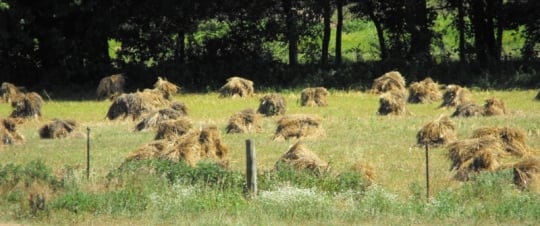 Love these photos today. This is oat threshing in the Amish community at Carroll County, Tennessee. You hear it pronounced “thrashing” as well. For some time I thought that was the official spelling. But I think that might just be the Amish accent (I’m actually partial to “thrashing”).
Love these photos today. This is oat threshing in the Amish community at Carroll County, Tennessee. You hear it pronounced “thrashing” as well. For some time I thought that was the official spelling. But I think that might just be the Amish accent (I’m actually partial to “thrashing”).
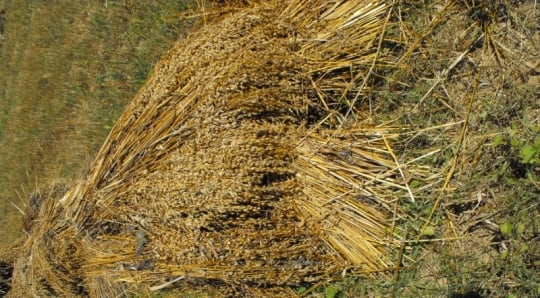
These photos were taken by Brenda, who previously brought us scenes from a laundry day in the same community. Brenda got permission to shoot this community’s “Oat Thrashing Day” last week, which she says involved around 50 men.
 These first four photos, however, were shot about a month ago, after the oats were cut, shocked, and left to dry.
These first four photos, however, were shot about a month ago, after the oats were cut, shocked, and left to dry.
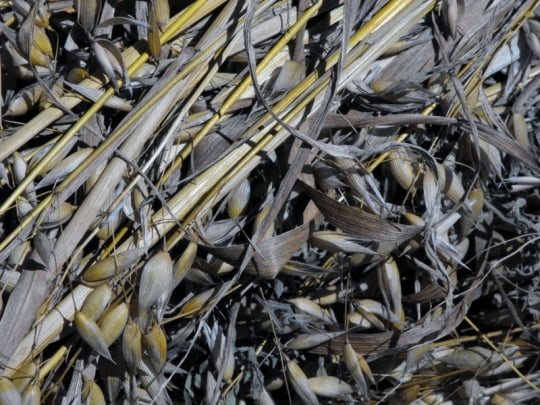
Threshing is the process of separating the edible part of a grain from the chaff. In English America this has been mass-mechanized. Amish have kept the horse. That means more labor. That’s not necessarily a bad thing, is it?
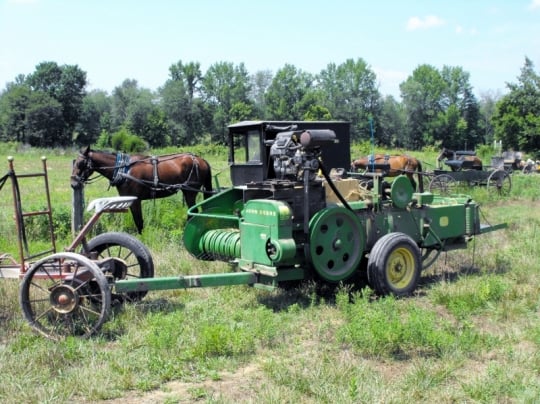
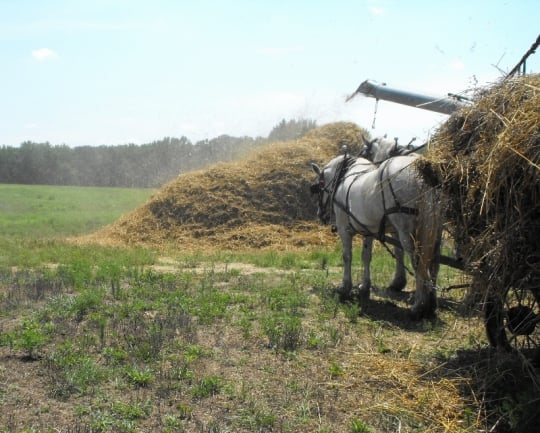
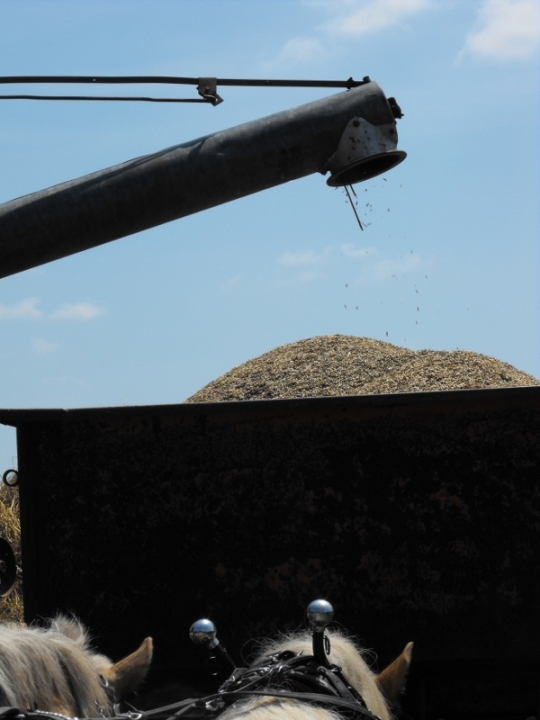
One thing for certain: this is hard work. “The little pony with the cart and wagon behind, had 6 little boys, age 3 – 7, and they were the ‘water boys’,” Brenda explains. “They would take the big water cooler out in the field for the ones loading the wagons.”
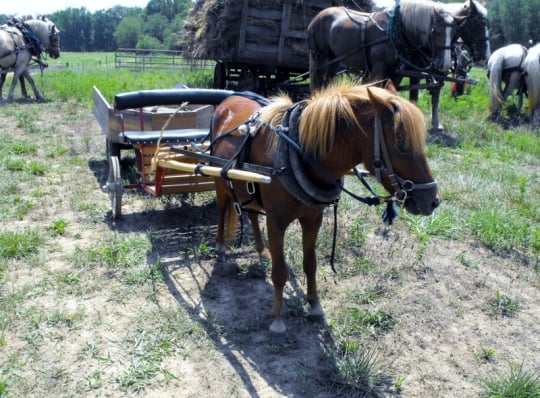
“I could have stood and watched for hours, however the heat index was 113 degrees, and not my kind of weather.”
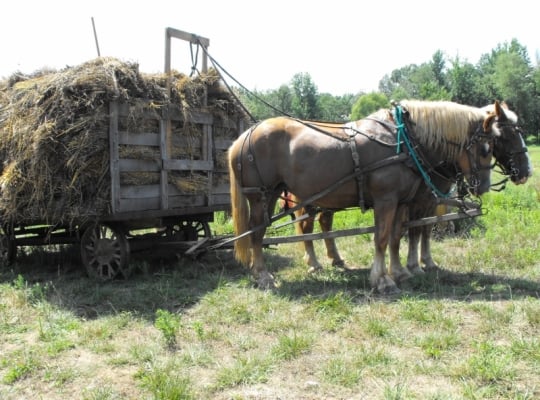
Amish threshing rings are made up of small groups of men who rotate among farms to do the job. The threshing ring embodies the strong Amish ethos of cooperation and mutual aid.
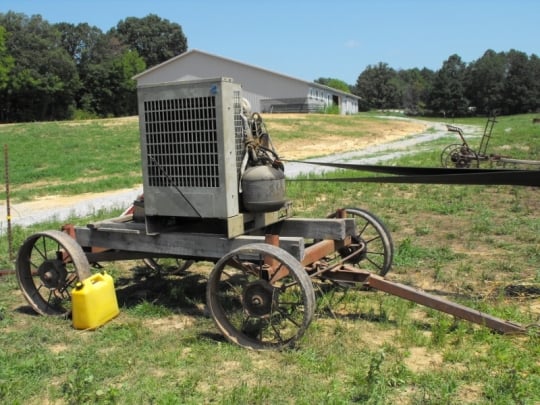
Changes in Amish work patterns have disintegrated this practice, however. As Amish have moved from farm to shop and factory, threshing rings are no longer needed. In “Lunch Pails and Factories” (See The Amish Struggle With Modernity p. 177), Thomas Meyers quotes an Amishwoman: “when people earn a lot of money they think that they can take care of themselves and don’t really need others. Our community used to have a bond.”
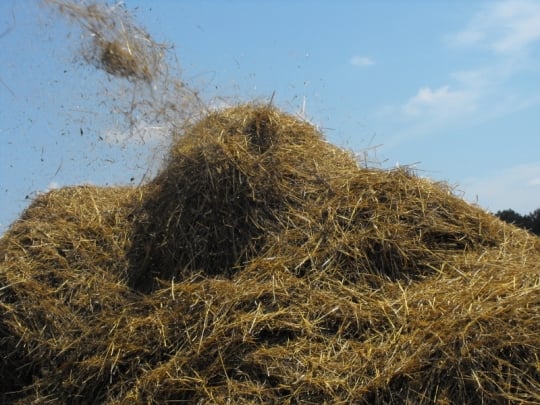
Threshing rings remain among farmers, however. And Amish do plenty of other cooperative jobs. The various work frolics involve Amish from all occupations, both men and women. However they may not occur with the same predictable regularity as threshing does.


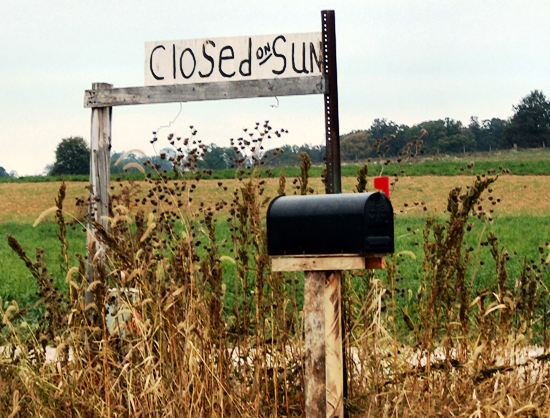
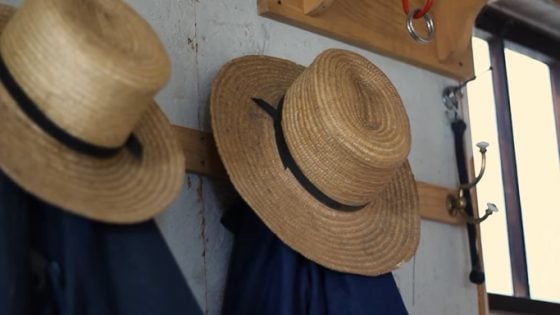
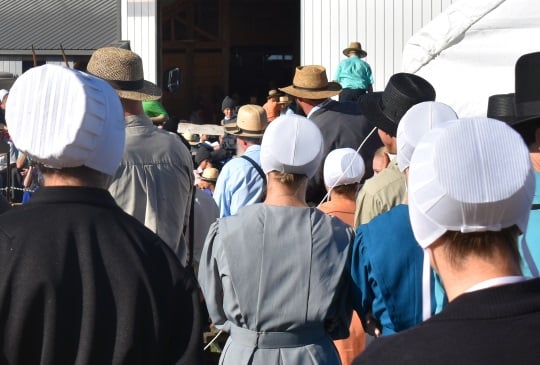
I enjoy for some reason looking into the fields around my way in Pennsylvania at the neatly laid-out hay stacks that seem to cover most of the land at times, with some that are not so neatly stacked but it still gets my attention for some strange reason. Its really amazing how very simple something like this can be yet can hold some of our attention, and compared to what’s been on TV the last 20 years or so staring at a farm field seems to be the more interesting choice I think! Richard. http://www.Amishstories.net
I saw a machine like is in picture ten and I had so idea what it was for. Now I know what it was for thanks to your pictures. There was no one around for me to ask what it was.
Thanks,
Marilyn
I agree with Richard, I’m not sure what the fascination is for me either, but whenever I see a field with those hay things, I just love it. I guess because it’s so peaceful looking and in a state of “waiting”. Great seeing pictures of the process – thanks for sharing those!
Love the pictures. Through out the years of traveling, I have always taken pictures of shocks and fields. Also horses.
I hope everyone enjoys viewing these photos as much as I enjoyed taking them. It was really hard to ‘not’ get a person in the pictures. Being one of the few English families to live in this Amish community, I guess I take a lot of their way of life for granted. They are like family to me. We visit daily, and many of the young children call me “Grandmother”. I will be happy to occasionally send photos to Eric, and if anyone has a request for a certain picture, I’d be happy to share it, as long as there are no faces shown. I do respect the fact that they do not want their picture taken! Thanks again to Eric, for sharing these with great explanation!
Brenda
Threshing
I can remember my father-in-law calling it something that sounded like “trashing”–maybe it depends upon where you are! He used to tell a story of doing it all by hand one year when the machinery broke down, like the characters in the Biblical story of Ruth.
Marta Perry
Not a bad thing at all
The threshing ring was the best time to be had for us men. We had to run around to each farm to shock(stack) the bundles the day they were cut, so we got together for that. Then we came back to that farm 2-3 weeks later to thresh. It was hard work, and the women had a hard day of preparation for a meal for all of us. BUT, the time spent with good friends made up for it.
Threshing season was the time when we most depended on the community to help do the work necessary. It was far too big of a job to do alone or even with your whole immediate family and it was the biggest event in the farming year. A close second is corn shredding, which takes place in the winter months. Temps are lot more comfortable, but something is different in the feel, probably the random days of work. Shredding happens as the need arises, threshing happens day after day, until its done, weather allowing.
Even though it made you feel hotter, bundle pitchers almost always wore shoes or boots. The reason was snakes. Apparently snakes like the shocks and hide in them, probably to catch the rodents that feed on the grain. When we come along and mess up their homes, they don’t like it. Most wagons have a snake or two in them when you got them empty. There were no live snakes in the grain wagon, so I shoveled grain! Occasionally, there was a dead one that went through the threshing machine. After what happened in Genesis, the Amish attitude is the only good snake is a dead snake.
Despite the heat, I loved threshing. I still do. I have been accused of being in love with a threshing machine by my Amish friends. I will always consider the men and boys of the threshing ring to be my very best friends on this earth. I hope to see all of them in the next life.
Thanks Brenda for sharing these pictures, I’m sure everyone enjoyed them….would have been great to be there and watch them….
My son Mark threshing
I read this to post to my son, Mark. He said that he had helped with the threshing this year. One of his friends called him and asked him to help. Mark said that in Pennsylvania Dutch, threshing is pronounced “drresha.” As Mark explained it to me there are about four or five jobs when threshiing. You have the pitchers. They are pitching the sheaves of oats on to the wagon. You have the stackers. They stack the sheaves while on the wagon. I’ve never seen it done. Mark says the heads are pointed out or something. Then you have somebody driving the team of horses pulling the wagon. When the wagon is loaded up to the top it heads for the threshing machine. In the meantime another wagon has been unloaded and is on its way back to the field. Back at the threshing machine the sheaves need to be pitched into the threshing machine with the heads of the sheaves going in first. The oats are separated from the chaff and the straw. The straw comes out baled. After threshing the straw needs to be stacked away in the hay mow. Mark says there are two threshing rings in his community each with its own antique thresher. They are belt powered to a tractor. Someday I would like to go out and see all of this in operation, myself. I just about can’t believe that my city born and bred son is out in the fields pitching oats. Oh, and he said that this Friday evening is the threshing supper for anybody that helped thresh. I guess I won’t be invited. But, in a way, I learn quite a lot about it just listening to Mark explain it to me.
Thanks for the info here Don, this does sound very interesting….maybe Eric can set up a trip for all of us who would like to go see this being done…I’m game….how about you Erik ?
I feel for the horses & ponies!
Interesting photos—I appreciate the close-up, too!
I just had to “feel” for those poor horses & pony! Do they get watered down (along with drinking water) in that heat? I know next to nothing (besides what I’ve learned here & from some horseback-riding friends) about horses & their care. Maybe you can tell me, Lance?
We’ve had several 100+ degree days in Illinois this year (drought, too), and I couldn’t live without air conditioning or at least some fans circulating the air .I’ve had heat stroke in the past—just “regular” heat (80’s-’90’s) literally gives me stomach cramps & worse. How do you know when the horses are heat-stressed?
Threshing or thrashing, it’s got to give you a feeling of satisfaction to complete the job, especially as part of a “team.”
Thanks,Brenda!
Alice Mary
horse care when threshing
As long as the horse is sweating, it is probably okay. If its body runs out of water, watch out, its in trouble. (Been there, done that, saved the horse, felt blessed, horse got a 14 day vacation). So, you water them before you go to the field, when you take a lunch break, when you go back to the field, and when you get back home. During our lunch break, we also gave the horses grain and hay, they are working hard too. In the severe heat of summer, you probably wanted to avoid ground corn, as it heats up in the horse. Oats are just fine, and not far away on threshing day.
People need lots of water, too. You can over do it real easy doing this task. One man did that in his early 20s and at almost 40, he is still unable to work on hot days. During cool weather, he is the hardest working man you could ever see, but on the hottest days, its all he can do to sit in the shade and drink water and live until tomorrow.
Thanks for answering, Lance. You are exactly right. It was just a few minutes before noon (lunch time) when these photos were taken. They were going to un-hook the horses, water and feed them, and hitch them in the shade until time to go back to work. I asked one of the men how in this world they could stand to work as they were in the heat? His reply was, “See how wet my clothes are? As long as I sweat, I am as cool as a cucumber.”
My son Mark threshing
I should mention something else, here. Mark helped thresh week before last when the temperature was in the 80’s and a nice breeze was blowing. The week before that he was also asked if he wanted to thresh but he declined. The temperatures were over 105. As Mark said to me: “Dad, I like to help thresh but I’m almost 60 and I know my limits. I’d be no help to anybody if I keeled over with heat stroke.”
Another thing he mentioned to me that I forgot in the last posting are the horse flies. They can just be fierce on the horses as they are out in the fields. This also adds to the difficulty in driving a team because the flies make the horses just miserable. This makes them ansy and unpredictable. I guess if I were standing somewhere and somebody was sticking a sewing needle in me every few seconds I would be ansy, too. I haven’t seen it for myself but Mark told me that when the horse flies bite they draw blood and really hurt. He said you can see little spots of blood all over the backs of the horses where they’ve been bit. When he is driving he likes to have one person walking along beside the horses just to swat the horse flies.
Oat shocks
I never knew that oat shocks had to be stacked in a certain way. I just thought they were stood up on end in a circle. Mark told me that there is a very specific way that oats are shocked. The oats sheaves are stood up three to a side leaning against each other. This makes like a little house. There is a front and back door to the “house.” These “doors” are faced into the prevailing winds so that the shocks dry out inside and outide. Then, one sheaf is fanned out and put on the top of the shock like a little thatched roof to shed off rain. Mark said that the shocks make nice little houses for all kinds of critters: garter snakes, great big spiders, and crickets among others.
One more little detail about the shocks
The bundle that is placed on top needs to have the seed end(top) placed towards the prevailing wind. The weight of the grain and the smaller size helps keep wind from blowing it off the shock. The butt end is thicker and flatter and the wind catches it easier. Still some shocks fall over and the top blow off. I never understood this, but no one ever put them back up.
Shocking bundles is scratchy, its best to wear long sleeves. Shocking grain with friends is fun, and the rewards is often homemade ice cream or fresh popcorn and homemade lemonade, plus a great time.
Wonderful photos! I would love to watch the threshing.
I’m just curious why you didn’t show a picture of the threshing machine? The machine in picture 5 is a baler. The machine in picture 10 would look to be the stationary engine used to run the threshing machine.
John, in order to get a picture of the actual McCormick threshing machine, I would have to had the workers in the picture. I wanted so much to get a shot of it, however I made a solemn promise to Mr. Yoder that NO men would be in the pictures. The machine is kept locked in a barn, but if I ever see it out, I will get a photo of it… promise. And yes, the John Deere machine is the baler for the straw.
To John Riegsecker: I clicked on your underlined name and found you have wonderful bird photos! I also like that you say what the name of each bird is. Very educational. Thank you.
Brenda, thanks for taking me back 40 years ago in memory.
Linda,
Sorry not to reply earlier, but I don’t often check the comments. I’m glad you liked the photographs. I also appreciate bird photographs more when I know what I am looking at.
No Thresher Picture
Brenda,
That’s unfortunate, as it would have been very interesting. I remember, as a small boy, when the threshers came to our farm. As about a 12 year old boy I remember driving my grandfather’s John Deere tractor with the hand clutch pulling the wagon to pick up bundles to bring to the threshing machine. My father always said shocking oats was the best way to harvest it, as oats was always so weedy, and shocking it allowed the weeds to dry.
Threshing machine
If you want to see a threshing machine photo from the 2007 Shirktown Threshers in PA, visit http://www.flickr.com/photos/rzfamily/sets/72157601299126698/.
To see a video of a threshing machine in action, see http://www.youtube.com/watch?v=rl37Py5lpW8.
Richard Herschberger from Arthur, Illinois has a photo of an oat binder at http://www.herschbergergalerie.net/10/lg/Oat_binder_.htm
Threshing machine
Hi Linda,
Thanks for the links, but I helped thresh as a small boy and have seen many threshing machines in operation. My first comment was prompted by Marilyn from NY who said she saw a machine like the one in photo 10 and didn’t know what it was until now. I was under the impression she thought that was a threshing machine. That is why I thought a picture of a threshing machine, rather than a picture of an engine in a post about threshing would prevent misunderstanding.
So how come the rest of farming America doesnt use a threshing machine any more? Well, they devised a way to combine the cutting part with the threshing part, and they called the new machine a … combine!
So when Johnny and Joey and Petey got big enough, they were sent off to the factory to make combines with cabs on them so Pop could sit in his air-conditioned combine and harvest the wheat. Johnny and Joey and Petey aren’t needed on the threshing crew anymore, but they did find jobs in the factory making combines.
End of story. 🙁
PA Threshers
If anyone near PA wants to see threshing, the first Saturday of every August is the last day of the Shirk reunion in New Holland PA. It used to be at the Shirk farm at Shirktown, but has grown so big they moved it last year to Big Spring Farm. The entire first week of August has always been the family reunion, and the last day of it has become open to the public. About 50/50 Amish / English. They start with threshing with belts beating it on canvas. Then move over to where two horses are driven in a circle connected to a wooden cross that is gear driven to a thresher. Then one horse is used on a treadmill belted to the thresher, and finally a steam traction engine (tractor) is belted to the thresher. A new combine (with A/C and stereo) is there for viewing, and is fired up and ran through the field spitting bales out the back.
There is an antique car club that brings vehicles and many locals bring hit and miss engines, pumps and driven equipment. Food, and a wood fired bread oven, making fresh baked bread is sold. There is usually a rack or boxes of the seasons left over seeds that are given away. Lapp Valley brings some equipment to make homemade icecream. It’s a long day and everyone pitches in at the end to clean up. (hopefully; still)
Anyone that takes a tour of the Lapp Valley Icecream Plant gets to walk the human treadmill at the end of the tour to run the machines a while. Yes, there are free samples.
The 60th Annual Thresherman’s Reunion is Aug 15 to 18 at Kinzers PA. Right on Rt. 30 between Gap and Paradise. This engine show dates back to when the newest equipment was being shown to engine men and threshers. There is a traction engine parade as well as antique tractor parade, a steam traction engine rodeo in an arena, sort of like tractor pulls doing tricks with the engines as well. Usually 15 or 20 engines and road rollers fired up at once for the week there. Wednesday is always the first day of the show, and includes Horse Progress Day. Since all the boilers are in one place at that time, the PA Dept of Labor and Industry has most of the boiler inspectors from the state to do the yearly inspections on all the boilers. So very few are fired up early that first day. Many fireboxes aren’t big enough to get through the door, so the grates are removed and the inspector crawls under the machine into the firebox to measure the crown sheet thickness (roof over fire) with a sonar thickness tester. (T-mike) The boilers need to be drained for the inspection, so it takes awhile to fill them and get fired up that first show day. Since the Lancaster County Inspector is the most familiar with antique boilers, (different laws than modern boilers) it’s a good chance to get the inspectors that see little to no antique pressure vessel inspections some experience.
There is a live steam Shay geared locomotive for train rides around the entire grounds as well as steam shovels, stationary steam room, and other exhibit buildings of antique gas lighting, hot air engines, a working forge, among many other interesting things. This is the largest gathering of steam and threshing equipment in the US.
http://www.roughandtumble.org/
Horse & human power
Paul, how I wish I lived near PA! Your description of the events at the end of the reunion sound very interesting to me. Horses on treadmills in one place, humans on a treadmill in another—heck, if I could walk a treadmill and get ice cream, I’d probably actually LOSE weight in the end!:) What an incentive that would be!
Talk of steam shovels always brings to mind one of my all-time favorite children’s books from my past—Mike Mulligan and His Steam Shovel (named Maryanne, if I remember correctly!)
Thanks for your info, Paul, and if you go to these events, I hope you keep your camera handy (in a way that’s respectful of the Amish, of course!)
Alice Mary
threshing orneryness
I read these posts to my son, Mark, who became Amish at the age of 50. He’ll be 60 on August 27th.
He said one of the things that happens when threshing, especially when teenage boys are helping, is some ornery teasing. At times, if one of the boys comes across a sheaf of oats that has thistle weeds in it (thistles have lots of stickers) they will pitch the sheaf and aim it at one of their buddies up on the wagon stacking the sheaves. You’ll hear a loud “OUCH! Watch out for the thistles!” Then the pitcher of the sheaf will get the offending thistle sheaf thrown back down on his head. Amish young folks get ornery, too, I guess.
threshing orneryness
Mark said another thing that the boys will do if one of their buddies is up on the wagon stacking is four or five of them pitching will all start pitching as fast as they can all at the one boy. He gets just pelted with oat sheaves hitting him all over. Mark said he has noticed that these antics usually happen early on in the threshing day. By the end of the day everybody is too tired to be too ornery.
Buwe sin Buwe, un Buwe bleiba Buwe
Boys will be boys and boys stay boys
Theshing supper
I was talking to Mark about last Friday evening. He told me he would be away from home because he was going the threshing supper. Anybody that helped with that year’s shocking or threshing was invited to come along with their family. The supper was held in the big barn at one of the Amish farms. There was a huge amount of food. Then the young and the young-at-heart played volleyball. I wasn’t invited to the supper. Hmmph.
Memories
The story and pictures brought back memories for me when I was a kid. My granfather and his brother had a “thrasher” they would pull all over the county and thrash grain for people. I was too young to remember that, BUT as a child I was always on a tractor doing the same jobs as the adults. As a 9 or 10 year old I was the tractor driver that pulled the binder, which my uncle rode. The binder would cut the crop…oats, fescue, wheat, etc etc…tie them in a bundle and when you had 5 bundles, maybe 6 you let your foot off a peddle and they were left on the ground, so you could come around later and shock them…..
Geting the thrasher ready to run was what seemed like an all day job….to me anyway….getting the machine level, and then getting it running just right. Ours was powered by an old Case tractor with a hand clutch and it ran the trasher attaching a belt to its flywheel. My job was to haul the shocks from the field to the thrasher…we would have two wagons unloading at the same time..As stated in the story it took several men to thrash a crop….while two were feeding the thrasher another would be sacking the grain, and another stacking the sacks on a wagon….with another crew loading in the field
When the thrashing was finished , out came the “old” New Holland baler with its Wisconsin gasoline powered engine, and was pulled around the straw pile to bale straw
It was hard work then and still is today, but that’s all we knew back then
I have several Amish friends here in Southern KY, and would go to their aid at the drop of a hat and feel they would do the same for me…I have been to one of their wedding receptions and was the only English there…and learned while at the table if you don’t fork it off the plate as it goes by it’s too late….LOL
Thanks for the reminiscence Danny, and the good Amish tableside advice. Have to move if you want a full belly!
Shirktown Threshing Day
http://lancasteronline.com/article/local/879961_Scenes-from-Shirktown-Threshing-Days-in-New-Holland.html
has 4 photos and two short YouTube videos from the 2013 Shirktown Threshing Day in New Holland, PA.
http://amishcountrylancasterpa.blogspot.com/2012/08/amish-church.html
has 10 photos of Shirktown Threshing Day in 2012, of other scenes on the grounds, more than the actual threshing. Included is a sand box filled with dried corn instead of sand!